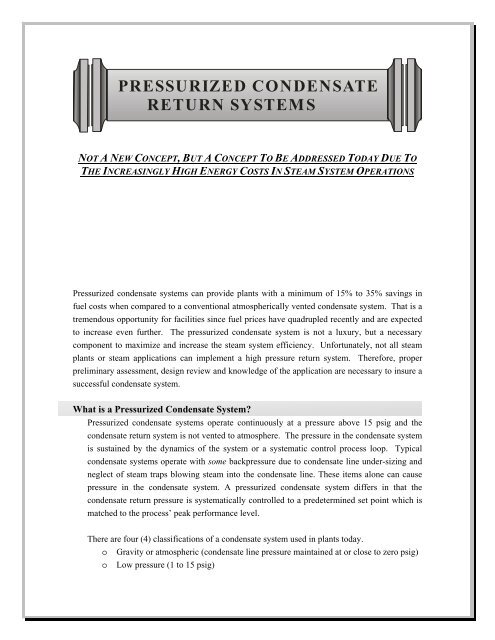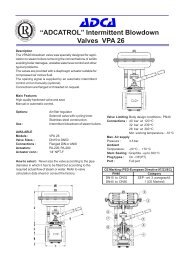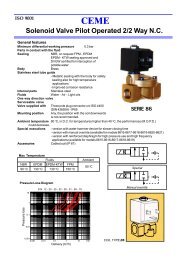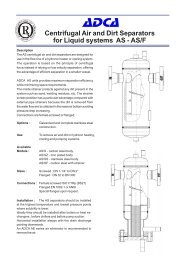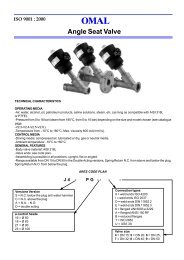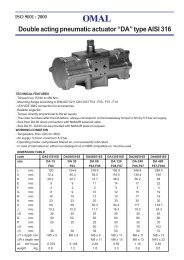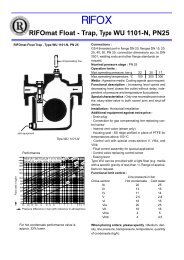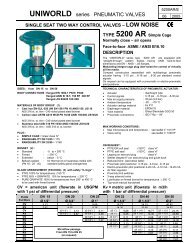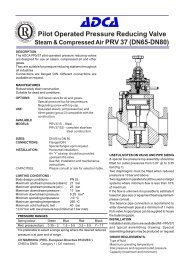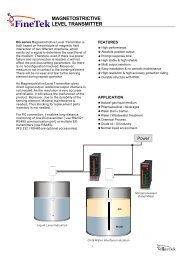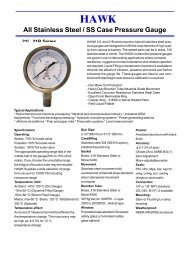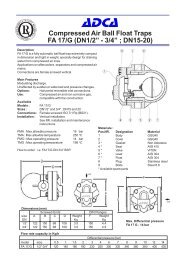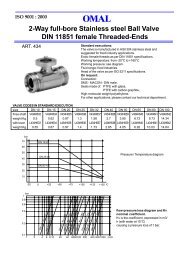PRESSURIZED CONDENSATE RETURN SYSTEMS
PRESSURIZED CONDENSATE RETURN SYSTEMS
PRESSURIZED CONDENSATE RETURN SYSTEMS
Create successful ePaper yourself
Turn your PDF publications into a flip-book with our unique Google optimized e-Paper software.
<strong>PRESSURIZED</strong> <strong>CONDENSATE</strong><strong>RETURN</strong> <strong>SYSTEMS</strong>NOT A NEW CONCEPT, BUT A CONCEPT TO BE ADDRESSED TODAY DUE TOTHE INCREASINGLY HIGH ENERGY COSTS IN STEAM SYSTEM OPERATIONSBYKelly PaffelTechnical ManagerPlant Support & Evaluations, Inc920-965-0114Kelly.paffel@plantsupport.comPressurized condensate systems can provide plants with a minimum of 15% to 35% savings infuel costs when compared to a conventional atmospherically vented condensate system. That is atremendous opportunity for facilities since fuel prices have quadrupled recently and are expectedto increase even further. The pressurized condensate system is not a luxury, but a necessarycomponent to maximize and increase the steam system efficiency. Unfortunately, not all steamplants or steam applications can implement a high pressure return system. Therefore, properpreliminary assessment, design review and knowledge of the application are necessary to insure asuccessful condensate system.What is a Pressurized Condensate System?Pressurized condensate systems operate continuously at a pressure above 15 psig and thecondensate return system is not vented to atmosphere. The pressure in the condensate systemis sustained by the dynamics of the system or a systematic control process loop. Typicalcondensate systems operate with some backpressure due to condensate line under-sizing andneglect of steam traps blowing steam into the condensate line. These items alone can causepressure in the condensate system. A pressurized condensate system differs in that thecondensate return pressure is systematically controlled to a predetermined set point which ismatched to the process’ peak performance level.There are four (4) classifications of a condensate system used in plants today.o Gravity or atmospheric (condensate line pressure maintained at or close to zero psig)o Low pressure (1 to 15 psig)
What are the Savings?High Pressure Return System Savings vs. StandardCondensate Return SystemFlash Steam Losses 149,235.84Heating the condensatefrom 212 o F (atmosphereconditions) to 240 F(deaerator conditions)19,618.56Make-up Water (heating toatmosphere conditions)20,067.84Approximate Chemicalloss or costChemical loss or cost 5,000.00Higher condensatetemperatures73,382.40Total Savings 267,304.64A typical example of an industrial application is highlighted below.
Typical details of one steam application in a process plant:Application:Steam PressSteam pressure supplied to the press: 190 psig (before a control valve)Equivalent Steam Temperature: 384°FSteam pressure at the press:150 psig (lowest process steam pressure)Steam flow rate:9,000 lbs per hour (minimum)Operation:7 days a week; 24 hours per dayNumber of days per year:312 (excludes preventive maintenance days)Condensate line pressure:Zero (vented to atmosphere and mechanicalpumped back to the boiler plant)Cost of steam (per thousand lbs): $ 12.10 (December 2005 pricing, expected toincrease)Boiler operating pressure:190 psigCurrent operating steam press conditionsA minimum steam requirement for the press of 9,000 lbs per hour provides 9,000 lbs per hourof condensate at 384 o F (the saturated temperature for the given pressure).Condensate is drained from the steam process through a steam trap. The steam trapdischarges to a vented condensate receiver system. When condensate is drained from theprocess at a given pressure (150 psig) and passes through a steam trap to a lower pressure (0psig @ 212 o F), then a percentage of the condensate will flash to steam. The ventedcondensate receiver allows the flash steam to be vented to the atmosphere and ultimately lostfrom the system.The percentage of flash steam loss that will occur is calculated as;357.698 (sensible heat at the higher pressure) – 180 (sensible heat at the lower pressure)970 (latent heat at the lower pressure)= 18.3 %Using this percentage we can calculate the loss of flash steam from the system as(9,000 lbs x .183) = 1,647 lbs of flash steam will be created and vented to atmosphere
If the cost of steam is $12.10 per thousand pounds, then1647 / 1000 x $ 12.10 = $ 19.93 per hour lossUsing the operational data, a total loss can be calculated due to flash steam alone.$ 19.93 x 24 hours = $ 478.32 loss each day of steam system operation and ultimately,over the course of 312 days per year accounting for preventive maintenance days whenthe system will be down,$149, 235.84 losses per year because of flash steam.Additional Energy InputLow temperature or pressure condensate returning from a conventional ventedcondensate system has to be heated to 240 o F in the deaerator process. Boiler plantoperation steam is used to heat the returning condensate. The deaerator process isreceiving make-up water that has to be heated to 240 o F in the deaerator. The make-upwater is required largely because of the flash steam losses.The specific enthalpy of the condensate returning from the process is 180 BTU/lb.Additional steam will be added to the condensate to raise the temperature from 212 °F tothe deaerator operating temperature of 240°F. The BTU content of condensate at 240°F is208 BTU/lb. Therefore, 28 BTU/lb (208-180 BTU/lb) are added to the condensate toincrease the temperature.So, 7,353 lbs per hour of returning condensate at 212 °F with 180 BTU/lb is changed tothe deaerator operating conditions of 10 psig and 240°F by adding 28 BTUs / lb or a totalof 205,884 BTU per hour.At 10 psig, the BTU content in steam is 952 BTU / lb. Steam costs were $12.10 perthousand pounds. So the system requires 205,884 BTU/hour, the steam contains 952BTU per pound and costs $12.10 for each 1000 pounds. This results in a cost of $2.62 perhour to heat the returning condensate.208 – 180 = 28 BTU’s per lb required to increase temperature to 240°F28 BTU’s x 7,353 lbs = 205,884 BTU’s per hour(205,884 BTU/ hour) * (1lb/952 BTU) * ($12.10/1000 lb)= $2.62 cost of energy per hour.Over 24 hours and 312 days this results in an additional energy input to system of$ 19,618.56 per year
Calculating the annual costs given the operational conditions results in $19,618.56 lossper year to heat the returning condensate at the lower pressure.Other losses in the systemThe flash steam loss will cause of loss of condensate, which will have to be replenishedwith the use of make-up water at a lower temperature and BTU content. In the firstsegment of the calculations, there was 18.3% of the condensate flashed as a result of theatmospheric vessel. This loss is replaced with make-up water and requires 1,647 poundsper hour.Make-up water BTU content: 80Condensate temperature:240 o FCondensate BTU content: 208208 – 80 = 128 BTU’s per lb required to increase temperature to 240°F128 BTU’s x 1,647 lbs (make-up required) = 210,816 BTU’s per hour(210,816 BTU/ hour) * (1lb/952 BTU) * ($12.10/1000 lb)= $2.68 loss per hour.Over 24 hours and 312 days this results in an additional loss of$ 20,067.84 per year loss in make-up waterSummary of Energy Losses with a Typical Vented Condensate Return SystemSummarizing all the losses, the atmospheric return system in this example will cost afacility $193,922.24.o Flash steam loss to atmosphere $ 149,235.84o Heating the condensate from 212 o F (atmosphere conditions)to 240 o F (deaerator conditions) $ 19,618.56o Make-up Water (heating to atmosphere conditions) $ 20,067.84o Approximate Chemical loss or cost $ 5,000.00Total loss from a vented system $ 193,922.24Identifying the loss in a monetary figure is the first step to developing an improvement plan.Pressurized condensate systems are an excellent method for reducing these losses by 90% ormore.
Results Implementing a High Pressure Condensate System and instituting the NewOperating ConditionsOnce a new high pressure condensate system is installed, typical losses will be greatlyreduced and the high pressure condensate from the steam press will operate nominally at 125psig @ 353 o F.High pressure condensate vessel (tank or deaerator) will maintain the condensatetemperatures at 125 psig @ 353 o F and the condensate will now be pumped directly back intothe operating boiler. The condensate was not exposed to the atmosphere and does not have togo through the deaeration process. The returning high pressure condensate can then bedelivered to a high pressure condensate tank system or a high pressure deaerator process,depending on the plant steam system configuration.The same process conditions as noted in the typical vented system in a process plant wherenow a pressurized return system is used:Application:Steam pressure supplied to the press:Steam Press190 psig (before a control valve)
Equivalent Steam Temperature: 384°FSteam pressure at the press:150 psig (lowest steam pressure to press)Flow rate:9,000 lbs per hour (minimum)Operation:7 days a week; 24 hours per dayNumber of days per year:312 (excludes preventive maintenance days)Condensate line pressure:125 psigCost of steam (per thousand lbs): $ 12.10 (December 2005 pricing, expected toincrease)Boiler operating pressure:190 psigNew Operating Conditions Energy SavingsFlash steamFlash steam from the process is greatly reduced, and the new smaller percentage of flashsteam is contained at a higher pressure (125 psig), which allows the plant to use the flashsteam for other applications, such as the deaerator process. The end result is no flashsteam loss to atmosphereThe percentage of flash steam that will occur is calculated as;357.698 (sensible heat at the higher pressure) – 324.913 (sensible heat at the lower pressure)868.686 (latent heat at the lower pressure)= 3.8 %Vented System = $149, 235.84 (loss)Pressurized Condensate System = 0 (loss)Make-up waterWith the flash steam being recovered, there is no flash steam loss, thus only need formake up water is to replenish the deaerator non-condensable vent losses. The makeupcosts are negligible in this example.Condensate temperatureThe condensate temperature is now higher than the deaerator, therefore the deaerator isnot required to heat the condensate and a steam savings actually occurs.325 Btu’s (new condensate BTU content) – 208 BTU’s (deaerator condensate or feedwater BTU content) = 117 BTU savings in Boiler Fuel
117 Btu’s x 9,000 lbs = 972,000 BTU’s$ 9.80 per hour savings in boiler fuel$ 9.80 x 24 = $ 235.20 per day$ 235.20 x 312 = $ 73,382.40 per year steam savingsSavings based on high temperature condensate vs. low temperature deaeratorfeedwater = $ 73,382.40 savings in steam.Chemical costWith no flash steam loss or make-up water there is no need for chemicals.(No chemical cost)Estimated at $ 5,000.00Summary of Energy Savings Using a Medium or High Pressure Condensate Systemo Flash steam loss to atmosphere $ 149,235.84o Make-up Water (heating to atmosphere conditions) $ 20,067.84o Approximate Chemical loss or cost $ 5,000.00o Higher condensate temperatures $ 73,382.40Annual total losses from a vented system when compared to a pressurized systemoperating at 110 psig. $ 267,304.64What are the Components Required?Before changing everything to a medium or high pressure condensate system, the first step isto insure the steam system and the steam processes will be able to operate with the desiredsystem.Flash Steam Recovery Systems (Non-modulating steam conditions)Condensate and flash steam (two-phase flow) discharging from a “non-modulating” steamsystem process can operate with a medium or high pressure condensate system.(1) A non-modulating steam condition refers to a system where there is no control valvemodulating the steam flow into the process to maintain a desired temperature or pressure.A process steam system that does not have a modulating steam control scheme for theprocess provides a constant steam pressure to the process. Therefore, if the returnpressure is constant, there is a constant pressure differential across the steam traps orcondensate discharge control valve.
(2) Additionally, a non-modulating steam condition may also refer to a system where a steamcontrol valve supplying the process will not modulate the steam pressure below apredetermined step point. This type of process arrangement will provide a variablepressure differential across the steam traps or condensate discharge control valve.However, the lower limit of the set point fixes a boundary on the variable of modulation.Examples of Non-Modulating Steam Processes:‣ Steam Tracing‣ Drip Leg Steam Traps‣ Unit Heaters‣ Process Heaters‣ Re-boilers‣ CorrugatorsFlash Steam Recovery Systems (Modulating Steam Conditions)A process with a steam supply modulating valve will result in the condensate and flashsteam (two-phase flow) being discharged as a modulating load. This means the processhas a steam control valve modulating throughout a full range from zero (closed) to 100%(full open) and any location in between. There is no limit on variability. The flash steamcannot be recovered in a pressurized flash tank or high pressure condensate returnsystem. The condensate flow from the process has to be discharged into a ventedcondensate receiver and then the flash must be recovered by an external heat exchanger
or vent condenser. The vent condenser will consume the flash steam by heating air,water, or some other process.A vent condenser typically will have a simple payback of 12 months or less depending onthe installation cost.In the case of a modulating steam process, it is best for the process steam system to usethe lowest possible steam pressure for the application, therefore producing the leastamount of flash steam.All process applications that have a modulating steam control valves must havecondensate drainage at or close to 0 psig or atmospheric pressure.How To Get Started?The first step is to have a steam and condensate audit conducted by plant personnel, or havean outside firm experienced in Steam and Condensate Drainage Systems assist with an audit.Today is a great day to get started with the current energy situation, tomorrow might be toolate…..


